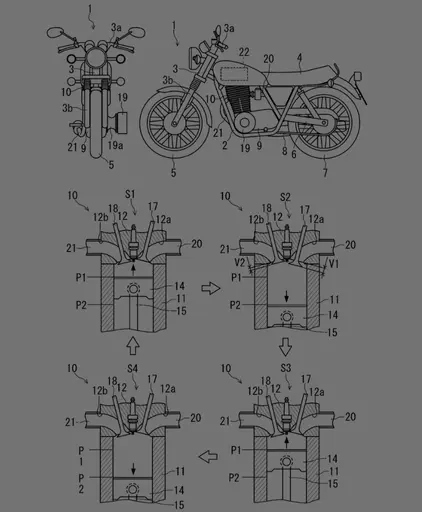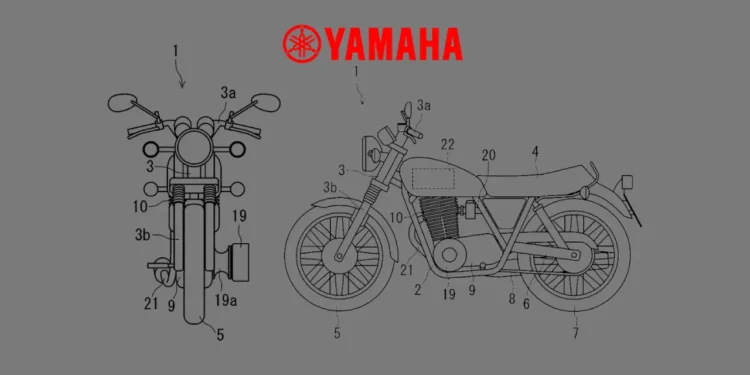Yamaha New Engine like Module for Electric Motorcycles : Yamaha has filed a patent for a saddle-riding type electric vehicle that recreates the emotions and sensations typically experienced with an internal combustion engine (ICE)—including intake roar, exhaust hum, and vibration—without burning a single drop of fuel. Instead of using a traditional engine, the bike uses a mechanical unit driven by the EV’s motor to mimic a four-stroke engine’s performance, while minimizing power loss that would typically occur during the compression of air inside a cylinder. This is Yamaha’s boldest attempt to solve the EV rider’s common complaint: “Great performance, but where’s the soul?”
Yamaha New Engine like Module for Electric Motorcycles: What Yamaha Has Patented
At the core of the design is a non-combustion engine unit: cylinder, head, piston, crankshaft, intake and exhaust valves—everything you would expect to see in a typical engine—except it doesn’t burn fuel. The EV’s traction motor rotates a crankshaft that moves a piston back and forth between a first position (near the head) and a second position (near the crankcase). As the crank turns, it also adjusts the timing of intake and exhaust valves, allowing air to pass through the intake and exhaust ports. This air movement generates genuine pressure waves—the same kinds of sounds you would get from a traditional ICE motorcycle.

The Four “Stages,” Reimagined
Yamaha has designed the piston’s motion to simulate four distinct stages of a typical four-stroke cycle:
- Stage 1 (Exhaust-like)
The piston moves upward, and the exhaust valve opens while the intake valve remains closed. The air in the cylinder is expelled primarily through the exhaust port and pipe, generating an authentic exhaust sound. - Stage 2 (Intake-like)
The piston moves downward, the intake valve opens wide (first opening V1), and the exhaust valve is slightly adjusted (second opening V2). Most of the airflow enters through the intake tract, creating a noticeable intake noise. Yamaha emphasizes the intake sound by ensuring V1 > V2 for a stronger intake sensation. - Stage 3 (Compression-like)
The piston moves upward again, but the exhaust path remains open slightly, preventing full compression. This reduces the load on the motor, lowering power loss while still producing audible exhaust sounds. - Stage 4 (Power-like)
The piston moves downward, with the intake and exhaust valves adjusted to allow air to pass. This final stage generates a second intake-like sound, enhancing the overall auditory experience. Throughout the four stages, the piston’s back-and-forth motion and the crank’s rotation create two vibrations per cycle that closely resemble the sensation of a traditional engine.
Real Pipes, Real Resonators, Real Acoustics
This is not just a speaker effect. The patent routes air through actual intake and exhaust pipes and optionally includes resonators. These Helmholtz-style chambers amplify the pressure waves, creating a fuller, more natural sound experience. The resonators enhance the bass-like exhaust pulses from the rear, while intake sounds are projected near the rider under the seat, offering a surround-style soundstage that feels mechanical because it actually is.
The Clever Bit: Cutting Power Losses
Previous attempts to simulate an engine’s sound and feel involved compressing air inside a cylinder, which resulted in significant energy losses. Yamaha’s system avoids this by modulating valve timing, which reduces the compression load and, in turn, the associated power loss. By carefully managing airflow through the intake and exhaust valves, the system creates sound and vibration without sacrificing efficiency.
Controls, Modes, and Everyday Use
Yamaha envisions two primary operating modes:
- Idle / Starting Mode
With the clutch disengaged, a start switch or even a kick-pedal-type starter commands the motor to rotate the crankshaft at a steady rpm. This mimics the idling vibration and sound of a conventional engine at rest. - Riding Mode
Once the clutch is engaged, the vehicle operates as a normal electric bike, but the engine-like module continues to run, adjusting its behavior in sync with the throttle. As the rider accelerates, the system’s sound and vibration increase in direct response, making the experience more immersive.
The system also includes modes that allow the rider to adjust the level of engine simulation: one mode for maximum character (louder, more vibration) and another for drive prioritization, which minimizes drag and optimizes range.
Packaging and Layout
The module is designed to fit like a traditional engine—cylinder, head, intake and exhaust plumbing—so it visually integrates seamlessly into a motorcycle frame. The traction motor can be mounted inline with the crankshaft, providing power to both the engine module and the gearbox, which ultimately drives the rear wheel via a chain. Yamaha also permits the use of separate motors: one for propulsion and another for the “engine-feel” system.
Why Riders Might Love It
- Authentic sensory feedback: Not just sound—genuine vibration from the crank and piston.
- Immersive acoustics: The intake resonator is placed near the rider, while the exhaust sound emanates from the rear for a balanced experience.
- Familiar rituals: Optional kick-style start, idle vibes, and throttle response recreate the emotional rhythms of riding a conventional motorcycle.
- Customization: Multiple modes allow riders to adjust sound and vibration intensity.
Trade-offs and How Yamaha Addresses Them
- Energy consumption: Any mechanical system that moves air incurs a small energy cost. Yamaha addresses this by modulating valve lift to minimize drag and using modes that adjust valve settings to optimize efficiency.
- Complexity and weight: The system is mechanically conventional and designed for easy manufacture and serviceability, despite the added components.
- Regulatory Noise: Yamaha’s system is highly tunable to meet global noise standards, thanks to resonators and adjustable valve timings.
How It Differs from Speaker-Based Systems
While many EVs use speakers to simulate engine sounds, Yamaha’s approach is mechanically driven, creating authentic vibrations and natural air movement that can be felt. It’s not just a recorded sound playing through speakers—this is a real, moving machine creating the sound.
Who This Is For
- ICE purists who love the visceral feel of traditional engines but want the benefits of an EV.
- Urban riders who want a quiet ride most of the time but enjoy a dramatic ride experience on weekends.
- New riders who appreciate EV simplicity but also crave an engaging, tactile learning experience.
Motors77 Take
Yamaha’s innovative patent bridges the gap between the world of traditional gasoline motorcycles and the clean, low-maintenance world of electric bikes. By combining real mechanical motion with audio and vibration feedback, it offers an experience that could redefine what it means to “ride” a motorcycle in the electric era.
Thinking about style + performance? Don’t miss our full deep-dive on the Yamaha XSR 155 India launch — pricing, specs & features for 2025










